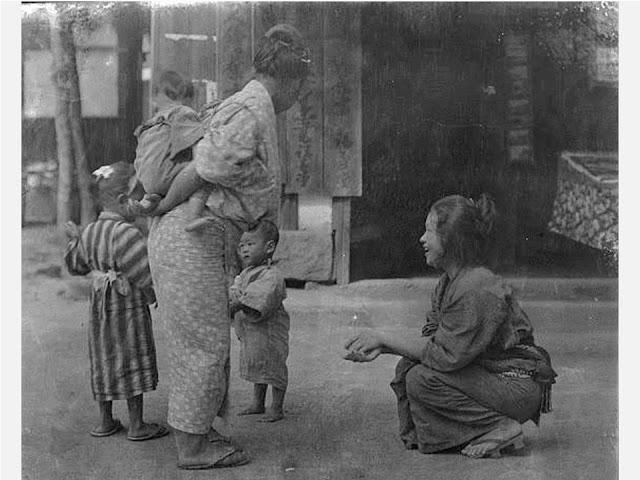I’ll highlight Yoshino’s mother in that year, who liked going out so much. She went out not only for herself but also for her family.
この年は、出かけ好きの主の母の外出も注目しています。母が良い役割を果たしています。
May、5月
On
the 13th, hikyaku messenger brough a letter saying that Yoshino
was ordered to go to Edo (old name of Tokyo) because his son was
suffering from a serious illness. He left early in the next morning. He
returned on the 18th, and wrote that Eiji became better. It’s good.
I knew that his son “Aisuke” changed the name to “Eiji” and worked
at Edo. The employer didn’t take care of him; what a heartless person. Next
month, Yoshino sent a talisman to Eiji. I totally understand how the father was
feeling.
13日、江戸から飛脚が来ました。「英次」と改名した愛輔さん(主の子)が大病なので、すぐに出府するよう書かれてました。主は翌朝出発し、18日に帰宅しました。「英次、少々、快候由」と書かれています。回復したようです。英次さんは江戸にいたのですね。しかし、奉公先は病気の世話をせず、冷たいものです。主は、翌月に、お守りを送っています。
5月の母の外出は三回。講と買物でした。
Jun、6月
On
the 5th, the official circular said, “Mito han
has fallen in an emergency since the 28th, therefore samurai are
moving day and night. ---“. Former samurai of Mito-han attacked the British
Legation in Edo on the 28th. Yoshino’s village was near the Mito
highway which linked Edo and Mito. They would become busy to help the traffic. The
historical event is written on the diary.
5日、小金町の役人からの廻文に、「去る28日より、水戸様御家中様方火急、昼夜御継立・・・」と水戸浪士の英公使館襲撃が記載されています。往来が増え、助郷が忙しくなります。
On the 25th, villagers (Jiuemon and Shigezou) came and said, “Jisaburou is too rude, so we took him into custody”. They probably shut down his house. Yoshino went there and knew Jisaburou reflected. Yoshino sentenced a punishment that he was prohibited from drinking for seven years. I don’t know what he did, but it’s interesting “temperance" was a punishment. He was sentenced to three-year temperance in February. Furthermore, he should willingly receive any kind of punishments, if he did something rude.
25日、村の次右衛門さんと繁蔵さんが「次三郎が不埒なので押し込んだ」とのこと。自宅の前に戸を立てて、幽閉したようです。主が出向いたところ、次三郎は反省しています。「七カ年禁酒」となります。次三郎さんは2月に「三カ年禁酒」と言われています。何をしたか分かりませんが、「禁酒」で償うとは面白いですね。更に、また不埒があったなら、どんな処置を受けても文句を言わないと約束させられました。
Yoshino’s
mother went out five times which included four udon noodle (below)
parties that were held after rice planting season every year.
In
July, she went out five times which included three Buddhist rites (Segaki)
because of Bon
season.
In
August, she went out eleven times; she went to kou (religious
group) and temple a lot.
Udon noodle
母の外出は五回、そのうち四回は田植え後恒例の饂飩の会に父と共に呼ばれました。
7月の外出も五回。お盆時期なので、三回は施餓鬼でした。
8月は11回。講と参詣が多いです。
September、9月
Although
there were many festivals in September, Yoshino’s mother went out only six
times including two funerals.
In
October, she went out eight times (funerals and celebrations of new born). She
stayed a night at her relative’s house during funeral.
In
November, she went out nine times. She visited her married daughter Oura to
celebrate the passage rite (Obitoki) of her grandchild and stayed two
nights. She and her daughter got along very well.
この月は、お祭りが多い月です。でも、母の外出は六回、内お悔やみが二回です。
翌10月は、八回の外出。お悔やみや出産の祝いがありました。大室の葬儀では、一泊して戻っています。
11月は、九回。駒木新田村に嫁いだおうらさんの家に帯解き(七五三)に行き、二泊しました。おうらさんと仲良し母娘ですね。
December、12月
On
the 2nd, Ryusuke went to Kawasaki in order to receive ofuda
talismans for disease prevention. Kawasaki is around 50km away from their
village and there is a very popular temple Kawasaki-Taishi. Ryusuke became old
enough to go out alone.
2日、隆介君が、武州川崎村へ痢病除けの御札をいただきに行きました。同行者がいたのかどうかは分かりませんが、遠出であり、隆介君の独り立ちは近そうです。
Kawasaki-Taishi in the New Year’s、川崎大師
On
the 5th, Yoshino’s mother went to Ka village together with Otoki in
order to buy medicine. His mother went there on the 6th and 7th
for the same errand.
On
the 9th, she visited Oura. On the 10th, she and her
husband were invited to a soba noodle (below) party.
On
the 11th, the village finished to pay rice-tax; villagers had an
overnight party as usual. They usually finished it in November, but it’s a
happy time anyway.
Soba noodle
5日、母は、病気のおときさんを連れて加村へ行きました。翌日、翌々日は母ひとりで薬を貰いに行きました。
母は、9日、おうらさんがいる駒木新田へ。翌日は、父と連れだって蕎麦を呼ばれに行きました。
11日、初御年貢皆済、日待。この年は、12月にずれ込んでしまいましたが、とにかく目出度い。
On
the 12th, Oyoshi invited Yoshino’s mother to a soba party. Oyoshi
took a husband five days later.
On
the 19th, Yoshino’s mother visited Jisaburou’s mother and offered
her thanks. Because, Jisaburou’s mother played a role as a matchmaker at the
marriage of Osata and Moritaya’s son on the 16th.
On
the 20th, she went to an indigo dyer's shop. On the 25th,
she went to the temporary market in Nagareyama with Ryusuke and Naohachi. She
prepared for the New Year’s Day.
Yoshino’s mother strengthened relations with Yoshino's neighborhood
and relatives. She often visited sick people, went
to funerals and went to celebrations of other families. She also attended the
Buddhist events and kou (religious group), especially she joined toki-kou nine
times together with her husband in that year. Moreover, she picked up her
married daughters and grandchildren and sent them off. She seemed to be an
ambassador of Yoshino family.
以下は、12日以降の母の動きです。
12日の夜に村の勘左衛門さん娘、およしさんに蕎麦に呼んでもらいました。およしさんは、17日に聟を取ります。
19日は、次三郎さんの母親にお礼に行きました。16日に、おさたさんの、流山の森田屋源兵衛さんの家への嫁入りの媒酌人をしてくれました。
20日は、紺屋へ、25日は流山の市へ、隆介君、猶八さんとともに行きました。正月準備ですね。
母は、近隣の付き合いを精力的にこなしていて、お見舞い、ご不幸があった時のお悔やみ、出産のお祝いなどに出かけています。また、施餓鬼など仏教行事への参加、他家での斎講(9回、父と共に参加)、結婚した娘と孫の送り迎えなど、家の外交担当というところです。
https://www.loc.gov/pictures/collection/agc/item/2018719799/resource/
Meanwhile, Yoshino closed the village's financial books on the 26th;
auditors were Hanzemon and Kanzaemon who were villagers.
On
the 28th, Zenzou of Hiraga village brought a salted salmon as usual.
I
thought that year would end peacefully, but the meeting to help logistics of
Mito kaidou (highway) was held on the 29th and he was summoned.
The work to support traffic and logistics was required more after the next
year.
一方、主人は26日に村の暮勘定。半左衛門さんと勘左衛門さんが立会でした。
28日は、例年のように平賀の善蔵さんが鮭の塩引きを持って来てくれました。
この年も穏やかに終わっていくのかと思いきや、29日、助郷の招集が来ました。翌年から助郷は増えていきます。
Yoshino’s daily life 01,
About Yoshino and background 吉野家とその頃
Yoshino’s daily life 02,
Life and fun of Yoshino family 吉野家の暮らしと楽しみ
The
details of their live which includes farming and visiting neighbors are written
in No.13 - No.25 (1851)、農事や近所付き合いを含む日々の詳細は1851年の日記の記事(No.13~25)に記載しています。
Yoshino’s daily life 13, The
first half of January in 1851(嘉永4年1月前半)
Previous
post: Yoshino’s daily life 46 (Jan. to Apr. In 1861、万延2年1~4月)
Next post: Yoshino’s daily life 48 (1862、文久2年)





Comments
Post a Comment